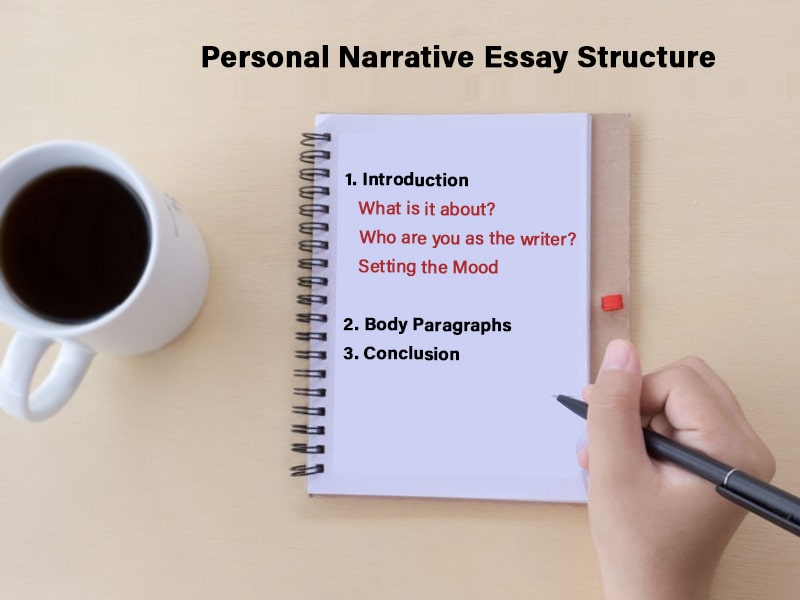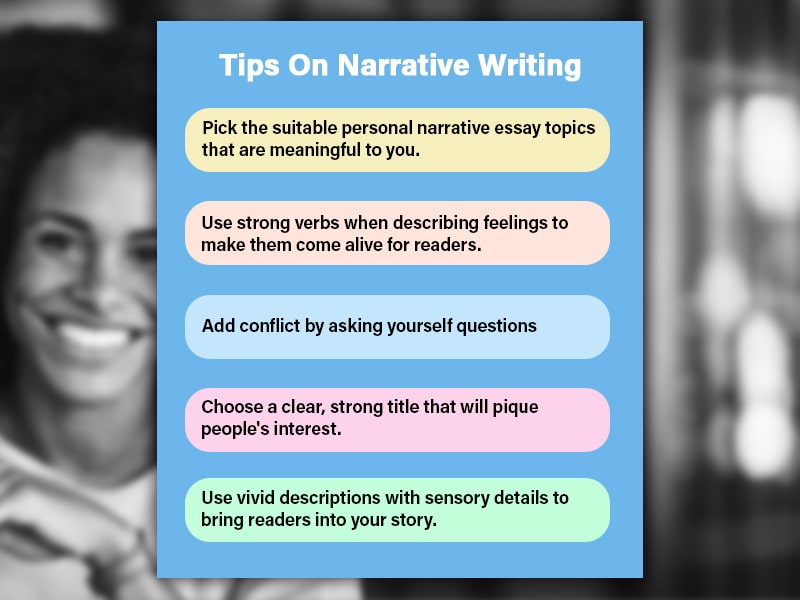Usually, high school or college students are expected to write personal narratives ideas based on their own lives.
Choosing the right personal narrative essay ideas or topics can have an impact on your school grade.
Here is the list of Best and Free 15+ Short Essay Examples
Also, not knowing the teaching writing prompts to write a personal narrative can make the process challenging and not interesting.
A writing prompt directs students as they write about a particular topic in a significant way, such as going on a trip with a friend or going to see your favorite movie.
Guiding prompts help to integrate students’ imagination and help them to write creative action for their school stories and get good grades in return.
When you write a personal narrative essay, it should capture the attention of a reader. The reader can be anyone- students, friends, teachers, or your family – and your writing should get them involved with events in your story.
You cannot use persuasive essay outline to write a personal narrative essay.
Table of Contents
What is a personal narrative essay?
As a student, you are probably asked to write an essay on your personal life. This assignment is typically called a “personal narrative” or “autobiographical” essay. It should include: A plot with conflict that reflects the writer’s relationship or feelings—characters who represent people in their journey-friends, family members, parents, classmates, etc. The goal is for readers to believe as though they are living through these events themselves.
If you want Best and Free Steps to Write an Explanatory Essay, click here
If it is difficult choosing from all the possible ideas we have listed below, try writing out the basic structure of what this paper might look like so that your teacher can tell whether or not this would be a good topic for you.
Personal Narrative Essay Structure

Introduction
To write personal narratives, the introduction needs to be captivating. Here are some pointers to make narratives attractive from the beginning. Such as,
- What is it about?
If you are looking to score a good grade, make sure you talk about what the story is about. For example, if you played hockey for the school, you could write an exciting story. The way you present the topic will impact the grade you will score on your story.
- Who are you as the writer?
The idea to write personal narratives rest on how you show readers what you experience. Having a unique experience of having a role model that particularly influenced you to write a narrative will raise your credibility and improve your chances of getting a better grade.
- Setting the Mood
A memorable ordeal with a favorite family member or going on a trip with your best friend and similar others helps set the mood for the story. However, this does not have to be explicit.
- Body Paragraphs
The following should be three or more paragraphs, each discussing a different event of personal significance that happened during your lifetime or to someone close to you. Each section should cover one specific event and include:
A beginning sentence clearly states where and when it occurred; An explanation of why the event was significant for you; an ending statement summarizing its impact on you emotionally or intellectually.
Each paragraph should cover one specific event and include:
- A beginning sentence that clearly states where and when it occurred.
- An explanation of why the event was significant for you.
- An ending statement is summarizing its impact on you emotionally or intellectually.
Remember, events don’t have to be positive-they’re just important to you, and that’s what matters. Write a great case studies with tips given here and impress tutors!
-
Conclusion
The conclusion of your essay can serve as either an additional message that your readers can take away or conclude with what has happened since then.
For example:
- Did anything change in your life?
- Has there been any reflection over time?
- Have goals changed at all because of this experience?
- What have you learned from writing this piece of content which will impact future endeavors such as schoolwork, career paths, lifestyle choices, etc.?
This should wrap up the narrative form and open up space for further dialogue between reader and writer if they find themselves asking questions after finishing reading.
Save Your Time & Money By Ordering Essays from Us
Challenges With Personal Narrative Ideas
In high school, students are asked to write a fun, memorable, and entertaining story. As a student, you might find it hard to develop personal narrative writing ideas or writing prompts that amuse the readers and make them want to continue reading the story.
Several factors affect Personal Narrative Ideas, such as:
- Students in high school have to write from memory. Since not all students have the same imaginative capacity, it cannot be easy to describe or write a story on their first day.
- Teachers might require students to write a new story every day. It is not a challenging task for some but can be frustrating for others who find it difficult to describe something original every day.
- Sometimes the teacher does not give enough time or consider how creative and imaginative students are. It’s true that your story can also be based on the world around you, but it doesn’t always have to be.
- If a student is not creative enough or has an overactive imagination, they might find it difficult to describe ideas for personal narrative for their writing prompts. One way to overcome this challenge is to search and read other narrative posts similar to the story they are telling. These posts, such as a blog, are free, and students can use this to get an idea when they write a personal narrative to get a good grade.
- It might be challenging for your professor or teacher to provide you with enough writing prompts, but by brainstorming on your own and trying out new things, you can’t help but have a good time.
Meanwhile, click here to know how to write and choose the best entertaining speech topics.
How do you come up with personal narrative ideas?
- First of all, as a writer, think about what interests you? What are some events in your life which have been memorable enough for you to share with others.One way to develop an idea for a personal narrative is by writing about a memorable moment that has happened in your life.
- Another option for writing a personal narrative is taking something favorite, funny, or a memorable moment that may have happened, such as your childhood or when you went on vacation. You can use such writing prompts from memory to create a relationship between your story and the entire class.
- A third way of brainstorming personal narrative ideas may be by writing an essay with the basic structure for the first time to get feedback from your teacher on what it might look like and whether or not this would be a good topic for a personal narrative essay.
- Some writing prompts for writing a personal narrative: include conflict, character, and plot points in your paper.
- Use dialogue when necessary to progress the storyline plausibly. Personal Narrative writing should have at least 3000 words but can go up to 6000 words in length.
This personal narrative does not need to happen though it could be fiction about your own life if you would instead tell this type of story.
Therefore, if you are looking for guidance on how to write a Narrative essay, these steps will definitely come in handy.
Also read: What is a case study?
Speaking of reading sources, if you want to view this copy offline, download the PDF here.
Tips on Narrative Writing

- Structure your story around a clear beginning, middle, and end with an introduction paragraph explaining who it is about and where/when it happened;
- Three body paragraphs on different events in order of importance (beginning, middle, or ending), each including what has just taken place; and
- Finally, an impact statement summing up how the event impacts your life.
2. Use strong verbs when describing feelings to make them come alive for readers. For example:
- “I felt baffled .”
- I was feeling very puzzled.”
- Avoid cliché phrases such as ‘it made me feel’.
3. Add conflict by asking yourself questions like the following:
- What did I want the protagonist to enjoy and not get?
- How did the conflict change him or her overtime?
- What was at stake for them if they failed to reach their goal?
4. Choose a clear, strong title that will pique people’s interest.
5. Use vivid descriptions with sensory details to bring readers into your story.
6. The last tip we’ll share regarding picking out the right narratives essay ideas or presentation themes concerns considering plans. Think about whether your chosen theme would feel rewarding after completion – maybe it’s something that others can relate to. This way, you can be sure that you’ll enjoy the final product and produce it with joy.
A well-structured essay requires attention to detail such as sentence variety, transitions between paragraphs, parallel construction, coherence among sentences within a paragraph, etc., which makes the process more interesting than just simply typing what’s on your mind without any editing.”
Excellent 5 Personal Narrative Ideas

-
Prewrite stories
Prewrite stories are one way that you can come up with great personal narrative essay topics because they usually start with portraying someone doing something. Then another character has to take care of the situation.
For example, your story could start with a character who is mad at his friend. The following sentence would be about the other person in this conflict and what they are doing to resolve it. That way, you can show both sides of the issue that’s happening.
The best part of prewriting stories for essays is getting the story out of your head and on paper. This helps you figure out how it should end, what to include in each scene, and whether it is a nice idea for an essay..
In general, prewriting stories are better than just coming up with ideas without any practice because they give you real-life situations to work with.
Prewrite stories allow students to think about their life events or a fun journey as potential topics when writing narrative essays.
-
Events in your life
There is no lack of events in your life, so choosing personal narratives from a child or teenager might be exciting but not too embarrassing. You could even use significant moments from childhood, such as playing on playgrounds at recess or going trick-or-treating for Halloween.”
You can also use a favorite moment made up in your head – like imagining if you were to go on a first date with Justin Bieber (or another pop-culture icon). You could even make the dates vary and come up with different outcomes for how they play out.
There are various ways that you can pick a good topic or write a personal narrative essay!
-
Clear Narrative writing
Keep in mind that clear narrative writing is the key to success
To be a good writer, you have to use clear narrative writing. Good writers can tell an engaging story with the help of descriptive words and writing prompts that make readers believe like they’re living in the event or experiencing it themselves.
Clear narratives also maintain focus on one key point without getting distracted by side points – which helps follow along with what’s happening. Be Clear with your Narrative writing: don’t use numbers or bullet points.
-
Use the first person in narrative writing.
Generally, the first-person is the best way to go when writing a narrative essay.
This perspective allows you to describe your story in detail and make it easier for teachers, students, or the class to connect with the writing that unfolds as they take place through your eyes.
When writing stories about yourself or other people who have been involved in a personal event, you can still choose this point of view if there are only two characters, such as “I” and “you.”
As mentioned before, personal narratives should include prompts, so consider using the third person limited during these parts of the story.
-
Edit your narrative writing
After you have finished writing your piece, it’s time to edit and polish what you’ve written.
One of the preferred ways to do this is by reading out loud or in your head. This will help find any missed spaces or words that may not sound right when being read aloud.
Additionally, as you are editing, make sure that there is a logical progression with each sentence leading into the next one, which leads to a coherent storyline for readers who follow along from the start until finish. Be careful about spacing throughout paragraphs so they don’t end abruptly without completing an idea first before moving on to another point of view.
(Bonus!) Go over your narrative writing with this checklist
Does each sentence have at least one complete thought? If not, make sure there are no fragments; otherwise, use semicolons between sentences to connect them.
Are there any sentence fragments? If so, remove them. Ensure that each sentence has one complete thought.
Do you have a concise introduction and conclusion to your story? The beginning should be intriguing enough for readers to keep reading to the end while giving an overview and theme or message about what is being discussed in your narrative form of writing.
A proper idea would be to start with why you felt it was important enough for others to read this story from your point of view instead of someone else’s perspective.
Different writers use different views on topics that can cause conflict in content when compared side by side against other essays and narratives.
Therefore, it is central to be able to articulate your thoughts and views on a topic.
If you want to get the best ideas on the narrative essay topics, follow the blog here.
Save Your Time & Money By Ordering Essays from Us
Conclusion
In conclusion, the right ideas for a personal narrative are all about choosing a meaningful topic for you and excitingly structuring your story. There are heaps of essays, but each has its instructions on how they should be structured for maximum impact. Choosing who will be involved with this story can also help readers get more involved with the content. The rest is up to you! All it takes is a little formation and creativity to develop an exciting story that readers will be eager to read.
If you love this blog but need a friend coming up with personal narrative Ideas, try Eduessay for a free prompt for your school essay and to get a good grade!
Want to view this blog offline? Download the PDF by clicking here.
- Harvard Outline Format – Quick Tips To Solve the Problem with HARVARD OUTLINE! - November 10, 2022
- How to Write a Movie Review? Get the complete guide here. - July 25, 2022
- Ultimate Guide On How To Write An Article Review: Useful Tips And Examples - March 1, 2022






